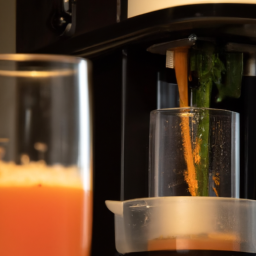Juice Tips and Tricks
How To Break A Juice Fast

I have personally tried a juice fast before, and I can confirm the amazing benefits it offers for your body and mind. It is crucial to pay attention to how you break your juice fast, as it can greatly influence the effectiveness of your detox and your overall well-being.
In this article, I will share with you the steps to take when breaking a juice fast to ensure a smooth transition back to solid foods. When breaking a juice fast, it’s important to understand that your body has been in a state of cleansing and healing. Introducing solid foods too quickly can shock the system and potentially undo all the hard work you’ve put in. That’s why it’s crucial to slowly introduce solid foods and listen to your body’s cues.
In the following paragraphs, I will go into more detail about the steps to take when breaking a juice fast to ensure a successful transition and continued health benefits.
Key Takeaways
- Gradually reintroduce solid foods to avoid digestive discomfort and undo the benefits of the cleanse.
- Pay attention to the body’s reactions to certain foods and incorporate high-fiber fruits and vegetables to maintain digestive health.
- Hydration is crucial during and after a juice fast, with water, herbal teas, and coconut water providing additional hydration and nutrients.
- Plan out meals ahead of time with whole, nutrient-dense foods and incorporate a variety of macronutrients to help keep feeling full and satisfied.
Understanding the Importance of Breaking a Juice Fast
You’re probably itching to eat solid food, but it’s crucial to understand the importance of gradually breaking a juice fast.
Your digestive system has been resting during the juice fast, and reintroducing solid foods too quickly can shock it and cause discomfort.
The goal is to ease your digestive system back into action while still reaping the benefits of your juice cleanse.
To achieve this, it’s important to have a post-fast meal plan.
This plan should include foods that are easy to digest and gentle on the stomach.
Start by incorporating soups, smoothies, and soft fruits such as bananas and avocados.
As your digestive system starts to adjust, start incorporating more complex foods such as steamed vegetables and lean proteins.
Remember to take it slow and listen to your body’s signals.
Slowly introducing solid foods after a juice fast is crucial for a smooth transition back to your regular diet.
By following a post-fast meal plan and listening to your body’s needs, you can ensure that your digestive system stays happy and healthy.
Slowly Introduce Solid Foods
Once you’re ready to reintroduce solid foods, it’s important to do so gradually to avoid any digestive discomfort. Start with simple and easy-to-digest options like soups or steamed vegetables. Gradual reintroduction of solid foods will give your digestive system time to adjust and avoid any sudden changes.
It’s essential to prioritize digestive health when breaking a juice fast. As you reintroduce solid foods, pay attention to how your body reacts to certain foods. Incorporate foods that are high in fiber, like fruits and vegetables, to keep your digestive system running smoothly. This will prepare your body for a return to a regular diet.
Incorporate Fruits and Vegetables
First and foremost, it’s crucial to incorporate an abundance of fresh fruits and vegetables into your diet to maintain digestive health after a juice cleanse. This is because fruits and vegetables are rich in fiber, which helps to regulate bowel movements and promote a healthy gut microbiome. Additionally, they provide essential vitamins and minerals that your body may have been deprived of during the juice fast.
To make the transition easier, you can start by incorporating fruits and vegetables into your diet in the form of smoothies. Smoothies are a great way to pack in a variety of fruits and vegetables into one delicious drink. Here’s a table of some smoothie recipes that can help you get started:
| Smoothie Recipe | Ingredients | Benefits |
|---|---|---|
| Green Smoothie | spinach, kale, banana, almond milk | rich in antioxidants and fiber |
| Berry Blast | mixed berries, Greek yogurt, honey | high in Vitamin C and protein |
| Tropical Paradise | mango, pineapple, coconut milk | packed with Vitamin A and healthy fats |
Incorporating these smoothie recipes into your diet can help you maintain the juicing benefits while still incorporating solid foods. It’s important to remember to hydrate properly during this transition period to avoid any digestive discomfort.
Hydrate Properly
When breaking a juice fast, it’s important to hydrate properly. Personally, I make sure to drink plenty of water throughout the day to replenish my body’s fluids. I also like to incorporate a daily intake of tomato juice as it’s rich in essential vitamins and minerals that support recovery after fasting. The natural electrolytes in tomato juice help maintain balance in the body, making it an ideal choice when reintroducing nutrients. This gradual approach ensures that my digestive system adjusts smoothly and efficiently.
I also like to include herbal teas and coconut water for added hydration and nutrients. It’s best to avoid caffeine and alcohol during this time as they can dehydrate the body and undo the benefits of the juice fast.
Drink Plenty of Water
To successfully break a juice fast and avoid dehydration, it’s crucial to drink plenty of water throughout the day. During a juice fast, your body is receiving hydration from the juice you consume, but it’s important to remember that water is still necessary for optimal health and hydration. Dehydration can lead to headaches, dizziness, and fatigue, which can be easily avoided by drinking enough water.
The importance of hydration cannot be overstated, especially during a juice fast. In addition to drinking water, there are other tips for staying hydrated during a juice fast. These include adding electrolyte-rich coconut water to your diet, avoiding caffeine and alcohol, and eating foods with high water content like watermelon and cucumber.
Including herbal teas and coconut water in your diet can provide additional hydration and nutrients to support your body during the transition from a juice fast.
Include Herbal Teas and Coconut Water
Including herbal teas and coconut water in your hydration routine is like giving your body a refreshing boost of vitality. Herbal teas are packed with antioxidants, vitamins, and minerals that help to detoxify and nourish your body. Some of the benefits of herbal teas include reducing inflammation, promoting relaxation, improving digestion, and boosting your immune system.
There are a variety of herbal teas to choose from, such as chamomile, ginger, peppermint, and lavender. Each tea has its unique set of benefits, so it’s worth experimenting with different types to find the ones that work best for you. Coconut water is another excellent option to add to your hydration routine. It’s a natural electrolyte drink that’s loaded with potassium, magnesium, and calcium.
Coconut water helps to rehydrate your body quickly and efficiently, making it an ideal choice after a juice fast. There are different types of coconut water to try, such as fresh coconut water, bottled coconut water, and flavored coconut water. Just be sure to choose a brand that doesn’t contain added sugars or artificial flavors.
With these refreshing options, you can keep your body hydrated and nourished after a juice fast, without feeling deprived or thirsty. As you transition back to solid foods, it’s important to avoid caffeine and alcohol. These substances can dehydrate your body and undo the progress you’ve made during your juice fast. Instead, opt for water, herbal teas, and coconut water to keep your body hydrated and energized.
Avoid Caffeine and Alcohol
You’ll want to steer clear of caffeine and alcohol to keep your body feeling refreshed and energized after your hydration routine. These two substances can be dehydrating and may cause your body to feel sluggish and tired.
Here are some tips for breaking a juice fast while still enjoying your favorite beverages:
-
Start with herbal tea: Herbal teas are a great way to ease back into solid foods while still getting the benefits of hydration. Choose teas that are caffeine-free and contain herbs that support digestion, such as ginger or peppermint.
-
Try coconut water: Coconut water is a natural electrolyte drink that can help replenish your body’s fluids and minerals. It’s also a great source of potassium, which can help regulate blood pressure and reduce bloating.
-
Sip on water: Water is the best way to stay hydrated, so make sure to drink plenty of it as you transition back to solid foods. Aim for at least 8 glasses a day to keep your body feeling refreshed and energized.
To prepare for breaking a juice fast and avoid common pitfalls, it’s important to listen to your body. As you reintroduce solid foods, pay attention to how your body responds and adjust your diet accordingly.
Listen to Your Body
When breaking a juice fast, it’s important to listen to your body. Pay attention to hunger and fullness cues to avoid overeating or rushing the process.
Taking time to chew and savor your food can help you fully enjoy your meal and prevent overeating.
Pay Attention to Hunger and Fullness Cues
It’s important to listen to your body’s cues of hunger and fullness when breaking a juice fast, so you don’t overeat and undo all the benefits of the fast. Mindful eating practices, such as paying attention to hunger and fullness cues, can help increase self-awareness and lead to significant weight loss and improved overall health.
When breaking a juice fast, here are some tips to help you pay attention to your hunger and fullness cues:
- Start by eating small portions. Eat slowly, giving your body time to adjust to solid foods again.
- Take breaks during your meal to assess your level of hunger and fullness. This can help you avoid overeating and feeling uncomfortably full.
Remember, taking time to chew and savor your food is an important part of mindful eating and can also help you pay attention to your hunger and fullness cues. By being present and aware during your meals, you can break your juice fast in a healthy and sustainable way.
Take Time to Chew and Savor Your Food
Savoring each bite of your food and taking time to chew it can enhance the enjoyment of your meal and promote mindful eating habits. Mindful eating is all about paying attention to the present moment, engaging all of your senses, and being fully present with your food.
When we eat too quickly, we tend to eat more than we need to because our brain doesn’t have enough time to register that we’re full. By taking the time to chew our food slowly and savor each bite, we allow our bodies to properly digest and absorb the nutrients from our food.
In addition to promoting mindful eating, taking time to chew our food can also have physical benefits. Chewing our food properly breaks it down into smaller pieces, making it easier for our bodies to digest and absorb the nutrients. By chewing our food properly, we also reduce the risk of digestive issues such as bloating and indigestion.
To improve your chewing techniques, try counting the number of times you chew each bite or putting down your utensils between bites to fully savor the flavors of your food.
By taking the time to savor each bite and chew our food properly, we can enhance our enjoyment of our meals and promote mindful eating habits. However, it’s important to remember not to overeat or rush the process, which we’ll discuss in the subsequent section.
Don’t Overeat or Rush the Process
To truly savor the flavors of your meal, it’s important to take your time and not treat it like a race to the finish line. Think of it as a leisurely stroll through a park, rather than a sprint to catch a train.
When breaking a juice fast, it can be tempting to overindulge and binge eat on all the foods you’ve been missing. However, this can lead to discomfort, bloating, and even nausea. Instead, practice mindful eating by taking small bites, chewing slowly, and paying attention to your body’s signals of hunger and fullness.
In addition, don’t rush the process of breaking your juice fast. It’s important to ease back into solid foods gradually, starting with simple and easily digestible options like fruits and vegetables. A helpful tip is to plan out your meals ahead of time, so you’re not caught off guard and tempted to reach for unhealthy options.
By taking the time to eat mindfully and prioritize your health, you’ll not only feel better physically but also mentally and emotionally.
Plan Your Meals Ahead
Make sure you’ve got a solid meal plan in place before ending your juice fast, so you can avoid reaching for unhealthy options out of desperation. Meal prep is a great way to ensure that you have healthy and satisfying meals ready to go when you break your fast.
Start by researching recipe ideas that incorporate whole, nutrient-dense foods, such as vegetables, fruits, lean proteins, and healthy fats. You can also pre-chop vegetables and prepare grains or proteins in advance to make meal prep easier throughout the week.
When planning your meals, aim to incorporate a variety of macronutrients, including carbohydrates, protein, and fat, to help keep you feeling full and satisfied. Don’t be afraid to experiment with new ingredients and flavors to keep things interesting and enjoyable. And remember, it’s important to listen to your body and adjust your meal plan as needed based on how you feel.
In order to make the most of your juice fast and ensure a safe transition back to solid foods, seek professional advice from a healthcare provider or registered dietitian. They can provide personalized recommendations for your individual needs and help you develop a plan that works for you.
Remember, breaking a fast should be a gradual process, so take your time and prioritize your health and wellness.
Seek Professional Advice
Before breaking my juice fast, I made sure to seek professional advice from a nutritionist. I wanted to ensure that my body received the necessary nutrients without overwhelming my digestive system.
I also got medical clearance to ensure that there weren’t any underlying health conditions that could affect my transition back to solid foods. Additionally, I considered joining a support group to help me stay motivated and accountable during the process.
Seeking professional advice and support can make a significant difference in the success of breaking a juice fast and transitioning back to a regular diet.
Consult with a Nutritionist or Dietitian
Consulting with a nutritionist or dietitian is essential if you want to avoid turning your stomach into a raging volcano after ending your juice fast. These professionals can provide you with personalized guidance on how to safely and effectively reintroduce solid foods into your diet.
They can also help you identify any potential nutrient deficiencies that you may need to address through dietary changes or supplements. Nutritionists and dietitians have a wealth of knowledge about food and nutrition, and they can offer valuable insights into how to maintain a healthy diet after your juice fast.
They can also help you develop a long-term eating plan that will support your overall health and wellness goals. Finding professional guidance from a nutritionist or dietitian is a smart way to ensure that you are making the best choices for your body and your health.
With their expertise and support, you’ll be well on your way to a smooth transition back to solid foods and a healthy, balanced diet. In order to ensure that you are in good health before and after your juice fast, it may be necessary to get medical clearance if needed.
Get Medical Clearance if Needed
After consulting with a nutritionist or dietitian, it’s important to also consider getting medical clearance before breaking a juice fast. This is especially important for individuals with pre-existing health conditions or those who have been on an extended juice fast.
Getting clearance from a medical professional can help ensure that you are following precautions and avoiding any potential health risks. It’s important to follow any recommendations or precautions given by your medical professional when breaking a juice fast. This may include gradually reintroducing solid foods, avoiding certain foods or drinks, or monitoring your symptoms closely.
By getting medical clearance and following precautions, you can ensure a safe and healthy transition back to solid foods. To further support your journey, consider joining a support group.
Consider Joining a Support Group
Joining a support group can provide valuable encouragement and community during your journey towards a healthier lifestyle. Here are some benefits of joining a support group:
-
Emotional support: A support group can provide a safe space for you to express your concerns and feelings, and receive empathy and understanding from others who are going through a similar experience. This emotional support can boost your motivation to stick to a healthier lifestyle, and help you cope with any challenges or setbacks along the way.
-
Practical tips: Support groups can also offer practical tips and advice on how to break a juice fast, such as what foods to introduce first, how to avoid overeating, and how to deal with cravings. You can also learn from others’ experiences and mistakes, and get a better sense of what works and what doesn’t for your body and lifestyle.
-
Accountability: Joining a support group can also help you stay accountable to your goals and commitments. Knowing that you have to report back to your group and share your progress can motivate you to stay on track and avoid slipping back into old habits.
When looking for a support group, it’s important to find the right fit for you. Consider factors such as the group’s focus, meeting frequency, location, and size, as well as the personalities and backgrounds of the members. You may also want to try out a few different groups before settling on one that feels supportive and helpful for you.
Support groups can be a great resource, but they’re just one part of maintaining a healthy lifestyle. In the next section, we’ll discuss some other strategies to keep in mind as you reintroduce solid foods and make long-term changes to your diet and habits.
Maintain a Healthy Lifestyle
To keep feeling great after your juice fast, it’s important to stick to a healthy routine that includes plenty of nourishing foods and regular exercise. After a period of fasting, your body needs nutrients to rebuild and repair itself.
Healthy meal planning should be a priority, incorporating a variety of fresh fruits and vegetables, lean proteins, and whole grains. Aim for balanced meals that are rich in vitamins and minerals, and avoid processed and sugary foods that can cause inflammation and other health issues.
In addition to a healthy diet, exercise routines are also important for maintaining a healthy lifestyle. Start with low-impact activities such as stretching, yoga, or walking, and gradually increase the intensity and duration of your workouts. Exercise not only helps you maintain a healthy weight, but also improves cardiovascular health, boosts mood, and reduces stress.
Remember to listen to your body and make adjustments as needed, and always consult with a healthcare professional before starting a new exercise regimen. With patience and dedication, you can continue to reap the benefits of your juice fast and maintain a healthy lifestyle.
Be Patient and Mindful
Being patient and mindful throughout your journey towards a healthy lifestyle can bring long-lasting benefits. When it comes to breaking a juice fast, it’s important to remember these principles.
Mindful eating is a practice that involves paying attention to the present moment and being aware of your thoughts, feelings, and physical sensations while eating. This can help you make better food choices and prevent overeating.
Patience and persistence are also essential when transitioning from a juice fast to solid foods. It’s important to give your body time to adjust to the change in diet, rather than rushing back into your old eating habits.
To practice mindful eating, start by paying attention to your hunger and fullness cues. Eat slowly and savor each bite, focusing on the taste and texture of the food. Avoid distractions such as television or scrolling through your phone while eating.
Additionally, try to choose foods that are nutrient-dense and provide your body with the fuel it needs to function properly. Lastly, be patient and persistent in your efforts towards a healthy lifestyle. Change takes time and effort, but the benefits are worth it.
By being patient and mindful during your transition from a juice fast to solid foods, you can set yourself up for long-term success. In the next section, we’ll discuss how to reap the benefits of your juice fast and continue on your journey towards optimal health.
Reap the Benefits of Your Juice Fast
Now that you’ve completed your juice cleanse, it’s time to capitalize on the benefits and sustain your healthy lifestyle. Maximizing the results of your juice fast can be done by easing back into solid foods gradually. Your digestive system has been resting during the cleanse, so it’s important to reintroduce solid foods slowly to avoid overwhelming your body and potentially undoing all the progress you’ve made.
To help you adjust to solid foods again, here’s a helpful table to guide you:
| Day | Solid Foods to Incorporate | Foods to Avoid |
|---|---|---|
| 1 | Raw fruits and vegetables | Processed foods, dairy, meat |
| 2 | Cooked vegetables, legumes | Processed foods, dairy, meat |
| 3 | Whole grains, nuts | Processed foods, dairy, meat |
| 4 | Lean proteins (fish, chicken) | Processed foods, dairy, red meat |
By following this table, you can gradually reintroduce solid foods into your diet while still maintaining the benefits of your juice fast. Remember to listen to your body and make adjustments as needed. With patience and mindfulness, you can successfully break your juice fast and continue to live a healthy lifestyle.
Frequently Asked Questions
Can I break my juice fast with any type of solid food?
Although tempting, it is not recommended to break a juice fast with just any type of solid food. When breaking a cleanse, it’s important to choose easily digestible options like steamed vegetables or fruits to avoid shocking the system.
How long should I wait before reintroducing caffeine and alcohol into my diet?
When reintroducing caffeine and alcohol, I wait at least a week after breaking my juice fast. I also take precautions when reintroducing dairy and gluten. Managing cravings can be done with tips and tricks like drinking water and distracting myself.
Can I continue to drink juice while reintroducing solid foods?
I can continue to drink juice while reintroducing solid foods. Juice fast benefits include providing essential nutrients and aiding in digestion. Juicing recipes for beginners can help with a smooth transition.
Should I expect any digestive issues when breaking my juice fast?
When breaking a juice fast, I should expect some digestive discomfort due to the sudden reintroduction of solid foods. Gradual re introduction can help ease this transition and prevent any discomfort.
Is it safe to exercise during the process of breaking a juice fast?
Exercising during a juice fast can be challenging, but hydrating properly is key to success. When breaking a juice fast, incorporating light exercise can aid digestion and enhance results. Listen to your body and start gradually.
Conclusion
In conclusion, breaking a juice fast is just as important as the fast itself. It’s crucial to introduce solid foods slowly and carefully, while incorporating fruits and vegetables and staying hydrated. As I’ve learned from my personal experience, listening to your body and seeking professional advice can help avoid any potential discomfort or health issues.
Did you know that according to a study by the University of California, San Francisco, juice fasting for just three days can help improve gut health, reduce inflammation, and boost the immune system? By breaking the fast properly and maintaining a healthy lifestyle, you can continue to reap the benefits of your juice fast.
Remember to be patient and mindful, and take pride in the positive changes you’ve made for your body and mind.
Cindy thoroughly researches juicing trends, techniques, and recipes to provide readers with practical advice and inspiration. Her writing style is accessible, engaging, and designed to make complex concepts easy to understand. Cindy’s dedication to promoting the advantages of juicing shines through her work, empowering readers to make positive changes in their lives through the simple act of juicing.
Juice Tips and Tricks
How Long Is Apple Juice Good For After Opening

Did you realize that the typical American eats around 12.3 pounds of apples annually? That’s quite a substantial quantity of apples!
And with all those apples comes a lot of apple juice. But what happens once you open that bottle of apple juice? How long can you keep it before it goes bad?
As an AI language model, I have researched and delved into the shelf life of apple juice after opening. Many factors can affect the shelf life of apple juice, including storage conditions, type of packaging, and the juice’s ingredients.
In this article, I will discuss the shelf life of unopened apple juice, factors that affect the shelf life of apple juice, how long apple juice is good for after opening, signs of spoilage, proper storage methods, and health risks associated with consuming spoiled apple juice.
Additionally, I’ll provide tips for reducing apple juice waste and disposing of old apple juice. So, let’s get started!
Key Takeaways
- Proper storage, such as refrigeration and tight sealing, can extend the shelf life of apple juice after opening up to 7-10 days.
- The presence of additives can affect the quality and shelf life of apple juice, so it’s important to check the label for safe additives and transparency.
- Signs of spoilage of apple juice include a sour or off smell, cloudy appearance, and change in taste, which can cause health risks if consumed.
- Uses of apple juice include using it as a base for smoothies, cocktails, baked goods, and sauces, and finding new ways to use it and donating unused juice can reduce waste.
Shelf Life of Unopened Apple Juice
So, you’re wondering how long your unopened apple juice will last? Well, according to the expiration date on the bottle, you can expect it to stay fresh for up to a year.
The shelf life of unopened apple juice is determined by the processing and packaging methods used by the manufacturer, as well as the storage conditions. The expiration date printed on the bottle is usually a conservative estimate of the shelf life, and the apple juice may remain safe for consumption beyond that date if it has been stored properly.
However, it’s important to note that consuming expired apple juice can lead to food poisoning and other health risks.
Now, let’s take a look at the factors that can affect the shelf life of apple juice.
Factors Affecting the Shelf Life of Apple Juice
When studying the shelf life of apple juice, it’s important to consider various factors that can affect its longevity. These factors include the storage conditions, quality of the juice, and presence of additives.
As someone who has researched the topic extensively, I’ve found that these three factors play a significant role in determining how long apple juice can last before it goes bad.
Storage Conditions
Proper storage, such as keeping the apple juice refrigerated and tightly sealed, can significantly extend its shelf life after opening. Temperature control and air exposure are two key factors that affect the quality and longevity of apple juice. When stored in the refrigerator at a temperature between 32°F to 40°F, apple juice can remain fresh for up to 7-10 days after opening. On the other hand, if left at room temperature or exposed to air, the juice can quickly spoil and may only last for a few hours.
To further illustrate the impact of storage conditions on apple juice, the following table highlights the shelf life of apple juice based on different storage methods:
| Storage Method | Shelf Life after Opening |
|---|---|
| Refrigerated and tightly sealed | 7-10 days |
| Refrigerated and loosely sealed | 3-5 days |
| Left at room temperature | 1-2 days |
| Exposed to air | A few hours |
As we can see from the table, proper storage is critical to extend the shelf life of apple juice after opening. However, it is important to note that even with proper storage, the quality of the juice may still deteriorate over time. In the next section, we will explore the factors that impact the quality of apple juice.
Quality of Apple Juice
You’ll want to pay attention to the flavor and texture of your apple juice, just like you would a delicate flower, since its quality can deteriorate over time.
While apple juice can be consumed beyond its expiration date, the taste and nutritional benefits may not be the same. The longer it sits, the more likely it is to lose its fresh taste and essential nutrients.
In addition to the natural degradation of the juice, taste preferences can also play a role in its quality. Some people may prefer the sweeter taste of newer apple juice, while others may enjoy the more fermented taste of an older juice. However, it’s important to note that the longer the juice has been open, the more likely it is to have a sour or even rancid taste.
So, it’s essential to keep track of how long your apple juice has been open and to consume it before it loses its quality or taste.
As we move into the next topic about the presence of additives, it’s important to consider how these additives can affect the quality and shelf life of apple juice.
Presence of Additives
Adding certain substances to apple juice can affect its quality and shelf life, making it important to understand the presence of additives. When purchasing apple juice, it’s crucial to check the label and ensure that all additives are safe for consumption.
Some additives, such as preservatives, are added to extend the shelf life of the juice. However, others may be added for flavor or color enhancement, which can negatively impact the quality of the juice over time. To ensure additive safety, it’s important to look for transparency on the label.
If the label lists ‘natural flavors’ without specifying the source, it’s difficult to determine the exact additives that have been included. Additionally, some additives may not be required to be listed on the label due to regulatory loopholes. Therefore, it’s important to research the manufacturer’s practices and reputation to ensure that they prioritize the safety and quality of their products.
Understanding the presence of additives is just one aspect of ensuring the longevity of apple juice. Now, let’s move on to discussing the shelf life of apple juice after it has been opened.
How Long is Apple Juice Good for After Opening?
Hey, don’t be chuggin’ that apple juice like there’s no tomorrow – it’s only good for about 7-10 days after opening. After that period, the quality of the juice starts to deteriorate due to exposure to air and bacteria. While some additives can extend the shelf life of apple juice, the presence of these additives can also affect the taste and nutritional value of the juice. So, if you’re wondering how long apple juice lasts, it’s best to consume it within that 7-10 day window for optimal flavor and safety. Beyond that, you risk changes in taste, color, and even an increased chance of harmful bacterial growth. To make it last longer, always store it in the fridge and ensure the bottle is tightly sealed after each use.
To make the most out of leftover apple juice, there are several ways to use it in cooking and baking. Apple juice can be used as a substitute for sugar or other sweeteners in recipes, adding a natural sweetness and flavor to dishes. Additionally, apple juice can be used in marinades and sauces to enhance the flavor of meats and vegetables. The benefits of apple juice for health are also well-documented, with studies showing that it can lower the risk of heart disease, improve digestion, and boost the immune system.
As important as it is to make the most out of leftover apple juice, it is equally important to know when it has gone bad. Signs of spoilage include a sour or off smell, a cloudy appearance, and a change in taste. If you notice any of these signs, it is best to dispose of the juice immediately to avoid the risk of foodborne illness.
Signs of Spoilage
As we discussed earlier, the duration of apple juice’s quality after opening varies depending on several factors. However, it’s essential to keep in mind that even if it’s within the recommended timeframe, apple juice could still be spoiled.
It’s crucial to be aware of the signs of spoilage to prevent health issues caused by consuming contaminated apple juice. Common contaminants in apple juice include bacteria, yeast, and mold, which could lead to off-flavors, discoloration, and even illness.
If you notice any peculiar odor or flavor, such as a sour or musty smell, throw the apple juice out immediately. Additionally, check the color of the juice; if it appears cloudy or has sediment, it could signify spoilage. Remember that it’s better to be safe than sorry when it comes to consuming expired apple juice.
Now that we’ve discussed the signs of spoilage in apple juice, it’s time to talk about proper storage to extend its shelf life.
Proper Storage of Opened Apple Juice
When it comes to storing opened apple juice, proper refrigeration and freezing techniques are crucial to maintaining its freshness and quality.
I always make sure to store my open apple juice in the refrigerator, as it can last for up to 7-10 days when stored at a temperature of 40°F or below.
If I don’t plan on consuming the apple juice within that time frame, I opt to freeze it instead, as it can last for up to 8 months when frozen at 0°F or below.
Refrigeration
Storing your opened apple juice in the refrigerator can significantly prolong its shelf life. Not only does refrigeration help maintain the quality and freshness of the juice, it also prevents the growth of harmful bacteria that could cause foodborne illness. As a result, refrigerated apple juice can stay good for up to seven days after opening.
While there are alternatives to refrigeration for preserving apple juice, such as canning or using preservatives, these methods may alter the flavor and nutritional value of the juice. Additionally, they may not be practical for everyday use. Refrigeration is a simple and effective way to extend the shelf life of your apple juice without compromising its taste or health benefits.
To further extend the shelf life of your apple juice, you can also freeze it. However, freezing can change the texture and taste of the juice, so it’s important to consider whether this is an acceptable trade-off for a longer shelf life.
Freezing
If you want to keep your apple juice fresh for longer, freezing it is an option. You can turn it into a chilly, icy treat that can be enjoyed at any time. Freezing apple juice in an airtight container is the best method to preserve its taste and quality.
Aside from being a refreshing drink, frozen apple juice has other uses. You can use it as a base for smoothies, cocktails, and other frozen beverages. You can also add it to recipes that require apple juice, such as cakes, muffins, and even sauces.
When freezing apple juice, it is recommended to use freezer-safe, airtight containers made of glass or plastic. Avoid using containers made of metal or paper as they can affect the taste and quality of the juice.
Freezing apple juice is a great way to extend its shelf life and create a tasty treat. There are plenty of uses for frozen apple juice, and it can be stored in a variety of containers. But can you extend the shelf life of opened apple juice? Let’s find out in the next section.
Can You Extend the Shelf Life of Opened Apple Juice?
As I researched the topic of extending the shelf life of opened apple juice, I found that adding preservatives is one option. Potassium sorbate and sodium benzoate are commonly used preservatives that can help prevent spoilage.
Another option is to re-bottle the juice in smaller containers with minimum headspace to minimize exposure to air and prevent bacterial growth. However, it’s important to note that both of these methods may alter the taste and quality of the juice.
Adding Preservatives
Preservatives can help extend the shelf life of apple juice, but it’s important to consider their potential negative effects on your health. Here are some things to keep in mind when considering the use of preservatives for your apple juice:
-
Natural alternatives: Instead of using chemical preservatives, consider using natural alternatives such as lemon juice or citric acid. These can help prolong the shelf life of your juice without compromising your health.
-
Impact on flavor: Preservatives can alter the flavor of your apple juice, so it’s important to choose a preservative that won’t affect the taste of your juice.
-
Proper storage: Even with preservatives, the shelf life of your apple juice will be affected by how it’s stored. Keep your juice in an airtight container in the refrigerator to prevent spoilage.
-
Health concerns: Some preservatives have been linked to health problems such as asthma and allergic reactions. Be sure to research the potential health risks of any preservative you plan to use.
When it comes to preserving your apple juice, it’s important to weigh the benefits and drawbacks of using preservatives. If you do choose to use them, be sure to follow proper storage techniques and consider natural alternatives to chemical preservatives. With these things in mind, you can extend the life of your apple juice without compromising your health.
As for re-bottling the juice…
Re-bottling the Juice
Re-bottling requires careful consideration to ensure the quality and freshness of your juice remains intact. When re-bottling apple juice, it’s important to use clean bottles and lids to prevent contamination. It’s also recommended to use glass bottles as they’re non-reactive and don’t contain any harmful chemicals that may affect the quality of the juice.
There are various re-bottling techniques that can help extend the shelf life of your apple juice. One DIY preservation method is to add a small amount of ascorbic acid or lemon juice to the juice before re-bottling. This helps to prevent oxidation and keep the juice fresh for a longer period of time. However, it’s important to note that re-bottling can only extend the shelf life of the juice to a certain extent. After a certain period of time, even with proper re-bottling techniques, the juice will eventually spoil and become unsafe for consumption.
Consuming spoiled apple juice can lead to various health risks, which we’ll discuss in the subsequent section about health risks of consuming spoiled apple juice.
Health Risks of Consuming Spoiled Apple Juice
Consuming spoiled apple juice can lead to potential health risks, such as stomach cramps and diarrhea. When apple juice goes bad, it can contain harmful bacteria that can cause food poisoning. Symptoms of apple juice poisoning may include vomiting, nausea, and fever.
It’s important to check the expiration date on the juice container before consuming it. If the container has been opened, the juice should be consumed within 7-10 days, even if it is refrigerated. To tell if apple juice has gone bad, check for any changes in color, texture, or smell. If the juice appears darker than usual or has a cloudy appearance, it may have gone bad. The texture may also be thicker or slimy, which is a sign of bacterial growth. If the juice smells sour or has a strange odor, it’s best to discard it.
Recycling and disposing of old apple juice is an important step in preventing environmental pollution. Pour the old juice into a compost bin or down the drain with plenty of water to dilute it. It’s important not to pour old juice down the sink without diluting it, as it can cause clogs in the plumbing system. Alternatively, you can recycle the empty juice container according to local recycling guidelines.
By taking these simple steps, you can ensure that old apple juice is disposed of properly and safely.
Recycling and Disposing of Old Apple Juice
When it’s time to say goodbye to your refreshing apple juice, make sure to dispose of it properly to avoid any potential harm to the environment. Here are a few ways to recycle and dispose of old apple juice:
-
Compost it: Apple juice makes a great addition to your compost pile. Its natural sugars and acidity can help speed up the decomposition process of other organic matter in your compost.
-
Use it for cooking: Expired apple juice can still be used to make delicious meals. You can use it in marinades, sauces, and even baked goods.
-
Donate it: If your apple juice is still good but you no longer want it, consider donating it to a local food bank or shelter.
Aside from recycling and disposing of old apple juice, there are also creative recipes you can try using expired apple juice. You can make apple cider vinegar, apple jelly, or even use it as a base for a homemade salad dressing. These recipes not only reduce waste but also provide a tasty way to use up your old apple juice.
Now, let’s move on to the next section about tips for reducing apple juice waste.
Tips for Reducing Apple Juice Waste
Now that we know how to properly dispose of old apple juice, let’s talk about ways to reduce waste in the first place.
One strategy is to get creative with the juice and find new ways to use it before it goes bad. There are plenty of recipes out there for using up apple juice, such as adding it to smoothies, marinades, and sauces. You could also try making apple cider vinegar or even apple jelly. By finding new uses for the juice, you can extend its lifespan and reduce waste.
Another option is to donate unused apple juice to those in need. Many food banks and shelters accept donations of non-perishable items like juice. This not only helps reduce waste, but also provides a valuable resource to those who may not have access to it otherwise.
Before donating, make sure to check the expiration date and only donate unopened or recently opened containers. By taking these steps, we can all do our part to reduce waste and make a positive impact on our communities.
Frequently Asked Questions
What are some common ways to use leftover apple juice that is close to expiring?
I love using leftover apple juice to make refreshing cocktails and delicious recipes. Some of my favorite recipes include apple cider donuts, apple cinnamon pancakes, and apple butter. For cocktails, try a spiked apple cider or an apple martini.
Is there a difference in the shelf life of organic versus non-organic apple juice?
Organic apple juice is made without synthetic pesticides or fertilizers, whereas non-organic may contain traces of them. The taste and nutritional differences are marginal, but choosing organic ensures fewer chemicals in your diet.
Can you freeze opened apple juice to extend its shelf life?
Yes, freezing opened apple juice can extend its shelf life. However, it’s important to follow best practices to ensure quality. Pour the juice into an airtight container, leaving room for expansion, and label with the date. Thaw in the fridge.
How long does apple juice concentrate last compared to regular apple juice?
Apple juice concentrate and regular juice differ in shelf life. Concentrate lasts longer due to its reduced water content. Leftover concentrate can be used to flavor smoothies or baked goods.
Is it safe to drink apple juice that has been left out at room temperature for several hours?
It is not safe to drink apple juice that has been left out at room temperature for several hours. Bacterial growth can occur and lead to foodborne illness. Proper refrigeration is recommended to ensure safety.
Conclusion
In conclusion, it’s important to know the shelf life of apple juice to avoid consuming spoiled juice.
Unopened apple juice can last up to a year and a half, while opened apple juice can last up to a week in the refrigerator. However, factors such as temperature, exposure to air and light, and the presence of bacteria can affect the shelf life of apple juice.
To reduce apple juice waste, proper storage and consumption practices should be observed. Recycling and disposing of old apple juice should also be done responsibly.
As the saying goes, "waste not, want not."By taking care of our apple juice, we not only avoid health risks, but we also contribute to a more sustainable environment.
Cindy thoroughly researches juicing trends, techniques, and recipes to provide readers with practical advice and inspiration. Her writing style is accessible, engaging, and designed to make complex concepts easy to understand. Cindy’s dedication to promoting the advantages of juicing shines through her work, empowering readers to make positive changes in their lives through the simple act of juicing.
Juice Tips and Tricks
How Long Is Canned Pineapple Juice Good After Expiration Date

As a fan of the taste of canned pineapple juice, I frequently ponder how long it stays consumable after the expiration date. I am aware that all canned items come with expiration dates, but what is the safe window for consumption of this juice post-expiration? Having encountered expired products previously, I comprehend the significance of adhering to guidelines to guarantee the safety of what we eat.
In this article, I will share my knowledge and experience on how long canned pineapple juice is good after its expiration date, as well as the signs of spoilage and proper storage techniques.
The expiration date on canned pineapple juice can be confusing, as it is often labeled with a ‘best by’ or ‘use by’ date. However, this date is not a strict deadline for when the juice will go bad. Instead, it is an estimate of how long the juice will maintain its optimal quality and flavor.
Past this date, the juice may still be safe to drink, but it may not taste as good as it did when it was fresh. In this article, I will explain how to determine if canned pineapple juice is still safe to drink, and what to do if it has gone bad.
Key Takeaways
- Unopened canned pineapple juice can last up to 2 years past the expiration date.
- Opened canned pineapple juice should be consumed within 7-10 days and stored in a refrigerator.
- Proper storage of canned pineapple juice involves a cool, dry place away from direct sunlight and heat sources.
- Brand and quality of canned pineapple juice can impact shelf life beyond expiration date.
Understanding the Expiration Date on Canned Pineapple Juice
So, you’re probably wondering how long you can keep drinking that canned pineapple juice past its expiration date, huh? Well, let me tell you, understanding that date is crucial for your health and safety.
First and foremost, it’s important to know that the expiration date on canned pineapple juice is the date after which the manufacturer can no longer guarantee the quality and freshness of the product. This means that the juice may not taste as good or be as effective after that date.
When it comes to understanding storage and packaging of canned pineapple juice, it’s important to note that the shelf life of the juice can vary depending on the storage conditions and packaging. If the can is unopened and stored in a cool, dry place, the juice can last for up to 2 years past the expiration date. However, if the can has been opened, the juice should be consumed within 7-10 days and stored in a refrigerator. Once opened, it is essential to transfer the juice to an airtight container to preserve its freshness and prevent contamination. Factors such as exposure to heat and light can also reduce the pineapple juice shelf life, which is why proper storage is critical. Always inspect the juice for off flavors, smells, or discoloration, as these are signs the pineapple juice shelf life has expired.
Understanding these factors can help ensure that you’re consuming safe and fresh canned pineapple juice. Now, let’s move on to the next question: how long is canned pineapple juice good for?
How Long is Canned Pineapple Juice Good For?
When cracking open that can of tropical nectar, it’s important to consider its freshness and whether it still packs a punch of fruity flavor. Canned pineapple juice has a shelf life of around one to two years, but this can vary depending on the brand and storage conditions. It’s advisable to check the expiration date before consuming the juice, as it can lose its nutritional value over time.
While canned pineapple juice can technically last beyond its expiration date, it’s important to note that the longer it sits on the shelf, the more its flavor and quality deteriorate. Additionally, exposure to heat and sunlight can cause the juice to spoil faster.
To ensure the best taste and nutritional value, it’s recommended to consume canned pineapple juice within a few months of purchase. In the next section, we’ll explore some signs that canned pineapple juice may have gone bad.
Signs that Canned Pineapple Juice has Gone Bad
If you’re not sure whether to take a sip of that fruity drink, here are some telltale signs that it’s time to toss out the can.
First, check the color of the juice. If it has turned dark or cloudy, it’s a sign that the juice has gone bad.
Second, smell the juice. If it has a foul or fermented odor, it’s another indication that it has spoiled.
Third, look for signs of mold or unusual growth in the juice. If you see anything that looks off, it’s best to discard the can.
Finally, taste a small amount of the juice. If it has a sour or off taste, it’s definitely time to dispose of it.
It’s important to note that using expired juice can be risky. Consuming spoiled juice can lead to food poisoning and other health risks. However, if you find yourself with a can of expired pineapple juice, there are still some uses for it.
You can use it as a marinade for meats or as a base for smoothies. Just make sure to use it up quickly and ensure that it is thoroughly cooked or blended before consuming.
Now, let’s move on to the next section and discuss proper storage of canned pineapple juice.
Proper Storage of Canned Pineapple Juice
To keep your can of pineapple juice fresh, you should store it in a cool, dry place away from direct sunlight and heat sources. Canned pineapple juice can last for a long time if it’s stored properly.
It’s important to avoid storing the juice in a place that’s too cold, as this can cause the juice to freeze and potentially spoil. One of the great benefits of canned pineapple juice is that it can be used in a variety of pineapple juice recipes.
From smoothies to cocktails, pineapple juice is a versatile ingredient that can be enjoyed in many different ways. Additionally, pineapple juice is known for its health benefits, such as aiding in digestion and providing a good source of vitamin C.
However, it’s important to remember that even with proper storage, canned pineapple juice will eventually expire. So, how can you tell if your canned pineapple juice is still safe to drink?
How to Tell if Canned Pineapple Juice is Still Safe to Drink
Determining the safety of your canned pineapple juice is easy – just check for any dents, leaks, or bulges on the can. However, even if the can looks fine, there are still potential risks to consider before consuming expired canned pineapple juice.
Here are some things to keep in mind:
- Bacterial growth can occur in canned pineapple juice over time, which can cause food poisoning and other illnesses.
- Changes in taste and texture may occur – even if the juice is still safe to drink.
- Nutrient loss can happen as the nutrients break down over time.
- If you’re not comfortable drinking the expired juice, consider using it in a recipe instead.
It’s important to determine whether or not the pineapple juice is still safe to drink before deciding what to do with it. If you’re unsure, it’s best to avoid consuming it.
What to Do with Expired Canned Pineapple Juice
So, you found a can of expired pineapple juice in your pantry, and you’re not sure what to do with it. As someone who’s dealt with expired canned goods before, I can tell you that proper disposal is key.
However, you might be surprised to learn that there are still some possible uses for expired canned pineapple juice.
Safe Disposal
Ironically, throwing out expired canned pineapple juice is probably the safest way to dispose of it. While it may be tempting to pour it down the drain or flush it down the toilet, doing so can have serious environmental impacts.
Pineapple juice contains high levels of sugar and acids, which can throw off the balance of bacteria in septic systems and water treatment facilities. This can lead to harmful algae blooms, fish kills, and other negative effects on aquatic life.
To dispose of expired canned pineapple juice safely, simply pour it into a plastic bag, seal it tightly, and throw it in the trash. This will ensure that it doesn’t leak out and cause harm to the environment. But before you do that, consider if there are any other ways you can use the juice.
In the next section, we’ll explore some possible uses for expired canned pineapple juice that can save you money and reduce waste.
Possible Uses
You may be surprised at the variety of ways you can repurpose expired canned pineapple juice through recipes and DIY projects. Don’t throw it away just yet! The sweet and tangy flavor of pineapple juice can add depth and complexity to your dishes and drinks. Here are some ideas to get you started:
| Recipes | DIY Projects |
|---|---|
| Pineapple Marinade | Pineapple Vinegar |
| Pineapple Dressing | Pineapple Jam |
| Pineapple Smoothie | Pineapple Syrup |
| Pineapple Cocktail | Pineapple Soap |
| Pineapple Sorbet | Pineapple Air Freshener |
Use the marinade or dressing to add flavor to your meats or salads. Blend the juice with other fruits and yogurt to make a delicious smoothie. Mix it with some rum and coconut milk to create a tropical cocktail. You can also experiment with making your own pineapple vinegar, jam, syrup, or soap. The possibilities are endless!
Now that you know how to reuse expired canned pineapple juice, it’s important to consider other factors that could affect its safety and quality.
Other Factors to Consider
When it comes to canned pineapple juice, there are a few other factors to consider beyond just the expiration date. As someone who’s experienced with this product, I can attest to the importance of paying attention to the brand and quality of the juice.
Additionally, the processing methods used can also have an impact on the taste and shelf life of the juice.
Brand and Quality
The brand and quality of canned pineapple juice can greatly impact its shelf life beyond the expiration date. Popular brands may have stricter quality control measures in place, ensuring that their products are of a higher standard. This can translate to a longer shelf life, even after the expiration date has passed.
Additionally, the nutritional value of the juice can also play a role in its longevity. A juice with higher sugar content may have a longer shelf life as sugar acts as a natural preservative.
When considering the brand and quality of canned pineapple juice, it’s important to also take into account the processing methods used. Some brands may use more advanced processing methods such as high-pressure processing (HPP) or flash pasteurization which can extend the shelf life of the product. However, it’s important to note that these methods may also affect the taste and nutritional value of the juice.
Processing Methods
By choosing a brand that uses modern processing methods, you’ll be able to enjoy a fresher and more flavorful pineapple juice. Modern processing techniques involve the use of advanced blending techniques that preserve the nutritional benefits of pineapple. These techniques ensure that the juice retains its natural sweetness, acidity, and aroma.
With modern processing methods, the juice is also packaged in a way that protects it from contamination and prolongs its shelf life. Apart from preserving the flavor and nutritional benefits of pineapple, modern processing methods also ensure that canned pineapple juice is safe for consumption.
These methods involve strict adherence to food safety guidelines, which include the use of only high-quality ingredients, thorough washing and sanitization of equipment, and strict quality control measures. By choosing a brand that uses modern processing methods, you can be confident that the canned pineapple juice you’re enjoying is not only delicious but also safe for consumption.
This is especially important given the importance of following guidelines for canned foods.
Importance of Following Guidelines for Canned Foods
Following guidelines for canned foods is crucial, as it’s like following a recipe to ensure that the end result is safe and delicious. Canned foods have an expiration date, and it’s important to adhere to this date to avoid any potential food safety issues. Canning is a common method for preserving fruits, vegetables, and even meats, but it requires strict adherence to best practices for preserving.
One important aspect of canning is to follow the processing time and temperature guidelines. These guidelines are specific to the type of food being canned and are designed to ensure that harmful bacteria are destroyed during the canning process. Another important factor is to use high-quality ingredients and equipment. This includes using fresh produce, properly cleaning and sanitizing equipment, and using tested and approved canning jars and lids. By following these guidelines, we can ensure that canned foods are safe and delicious to consume.
| Canning Best Practices | ||
|---|---|---|
| Use fresh produce | Properly clean and sanitize equipment | Follow processing time and temperature guidelines |
| Use tested and approved canning jars and lids | Store canned goods in a cool and dry place | Check for any signs of spoilage before consuming |
Frequently Asked Questions
Can I still use canned pineapple juice after the expiration date?
I wouldn’t recommend using canned pineapple juice after the expiration date. However, there are alternative uses such as marinades or in smoothies. To extend the shelf life, refrigerate after opening and consume within a few days.
How long does canned pineapple juice last if it has been opened?
I’ve found that once opened, canned pineapple juice should be consumed within 7-10 days and stored in the refrigerator. In my experience, the shelf life of other canned fruit juices is similar. I often use pineapple juice in recipes for marinades, cocktails, and baking.
Can canned pineapple juice be frozen for longer storage?
Oh sure, go ahead and freeze that canned pineapple juice for longer storage. Because nothing says "delicious"like thawed, watery juice with a side of freezer burn. But hey, at least you’ll have plenty of time to experiment with recipe ideas and flavor variations.
What are some uses for expired canned pineapple juice?
As someone who has experimented with expired canned pineapple juice, I have found that it can be used in creative recipes such as marinades, smoothies, and even as a replacement for vinegar in salad dressings. Alternative uses include using it as a natural cleaner or in DIY beauty treatments.
Are there any health risks associated with consuming expired canned pineapple juice?
Consuming expired canned pineapple juice can lead to potential health risks, such as food poisoning and gastrointestinal issues. Proper disposal techniques should be followed, as drinking it can be dangerous. As an expert, I strongly advise against consuming expired canned pineapple juice.
Conclusion
As I sip on my freshly opened can of pineapple juice, I can’t help but think of the expiration date stamped on the bottom. But fear not, for I’ve learned that canned pineapple juice can still be safe to consume after the expiration date has passed.
It all comes down to proper storage and understanding the signs of spoilage. Just like the sweet and tangy fruit itself, canned pineapple juice has a shelf life. But don’t let that discourage you from enjoying its refreshing taste.
With a little knowledge and care, you can savor the flavor of canned pineapple juice for weeks or even months past its expiration date. Remember to store it in a cool, dry place and check for any signs of spoilage before consuming.
And if all else fails, don’t be afraid to get creative and find a new use for that expired can of pineapple juice. After all, sometimes the best things come from unexpected places.
Cindy thoroughly researches juicing trends, techniques, and recipes to provide readers with practical advice and inspiration. Her writing style is accessible, engaging, and designed to make complex concepts easy to understand. Cindy’s dedication to promoting the advantages of juicing shines through her work, empowering readers to make positive changes in their lives through the simple act of juicing.
Juice Tips and Tricks
How Long Is Apple Juice Good After Opening

As a fan of apple juice for breakfast, I frequently contemplate how long an open bottle can last in the refrigerator before going bad. Because nobody wants to drink spoiled juice!
In this article, I’ll be exploring the factors that affect the shelf life of apple juice, explaining how to understand best before dates, and offering tips for extending the shelf life of your juice.
First, it’s important to understand that the shelf life of apple juice can vary depending on a number of factors. These include things like the type of juice, how the juice was processed, and how it was stored. By understanding these factors, you can make better decisions about how long to keep your apple juice and how to properly store it to maximize its shelf life.
Key Takeaways
- Proper storage in airtight containers at 32-40 degrees Fahrenheit can extend the shelf life of apple juice and retain its nutritional value.
- Pasteurization and packaging that limits oxygen exposure can also extend the shelf life of apple juice.
- Checking the expiration date is important for food safety, as expired apple juice can cause food poisoning and severe dehydration.
- Expired apple juice can be repurposed as a marinade or ingredient in baking, and freezing can also extend its shelf life.
The Factors That Affect the Shelf Life of Apple Juice
Hey, curious about how long your apple juice will last after opening? Let’s talk about the factors that affect its shelf life! Once opened, how long apple juice lasts depends on several factors, such as storage conditions and whether it’s pasteurized or freshly squeezed. If stored in the fridge at the proper temperature, pasteurized apple juice can last for about 7-10 days. Freshly squeezed juice, on the other hand, has a much shorter shelf life and should be consumed within 2-3 days for optimum freshness.
Apple juice preservation techniques have a significant impact on its shelf life. One of the most critical preservation techniques is pasteurization, which involves heating the juice to a high temperature to kill any bacteria present. Pasteurization helps extend the shelf life of apple juice by several weeks.
Another factor that affects the shelf life of apple juice is the packaging. Oxygen is one of the primary factors that can cause apple juice to spoil. Packaging that allows less oxygen to come in contact with the juice can help extend its shelf life. This is why apple juice is often packaged in airtight containers, such as tetra packs or glass bottles. The type of packaging material and storage conditions can also affect the shelf life of apple juice.
Understanding best before dates is crucial when it comes to consuming apple juice that’s been opened.
Understanding Best Before Dates
Wow, you can’t believe how crucial it is to understand best before dates!
It’s important to note that the ‘best before’ date on food labeling refers to the quality of the product rather than its safety. This means that consuming a product after the best before date doesn’t necessarily mean that it’s unsafe, but it may not taste as good or retain its intended texture.
However, it’s crucial to follow the ‘use by’ date if it’s provided, as consuming a product after this date can be harmful to your health.
Understanding food labeling and the importance of best before dates can help reduce food waste and its environmental impact. By throwing away food that’s still safe to consume, we’re contributing to the growing issue of food waste and its impact on the environment.
In fact, according to the United Nations, if food waste were a country, it would be the third-largest greenhouse gas emitter, after the United States and China. By understanding food labeling and consuming products before their use by date, we can reduce our contribution to this issue and help create a more sustainable future.
As important as it is to understand best before dates, it’s also crucial to know when your apple juice has gone bad. So, how can you tell if your apple juice has gone bad? Let’s explore the signs in the next section.
Signs That Your Apple Juice Has Gone Bad
One way to determine if your apple juice has spoiled is by checking for changes in its color and smell. Spoiled apple juice will have a darker color and a sour odor. You may also notice the presence of mold or sediment in the container.
Another sign of spoilage is if the juice has a fizzy or bubbly texture. If you notice any of these changes, it’s best to discard the apple juice as it may cause food poisoning.
However, if you do find yourself with expired or spoiled apple juice, there are still a few ways to use it. One option is to use it as a marinade for meat or vegetables. The acidity in the juice can help tenderize the meat, while also adding a sweet and tangy flavor.
Another option is to use it as an ingredient in baking. Apple juice can be used in place of milk or water in many recipes, adding a subtle apple flavor to your baked goods. With these alternative uses for spoiled apple juice, you may be able to salvage some of it before having to throw it away.
Moving forward, there are also some tips for extending the shelf life of apple juice that can help prevent spoilage.
Tips for Extending the Shelf Life of Apple Juice
If you want to keep your apple juice fresh for as long as possible, try storing it in the fridge or freezer. The cold temperature helps slow down the growth of bacteria, which is the main cause of spoilage in juices.
To get the most out of your apple juice, it’s important to choose the right storage method. If you’re planning to consume the juice within a few days, keeping it in the fridge is the best option. However, if you’re looking to keep the juice for a longer period, freezing it is a great way to extend its shelf life.
Aside from storing apple juice properly, there are also ways to repurpose leftover apple juice. You can use it as a marinade for meats or as a sweetener for baked goods. Additionally, drinking apple juice daily has numerous benefits such as improving digestion, boosting immunity, and reducing the risk of chronic diseases.
By following these tips and incorporating apple juice into your daily routine, you can reap its health benefits and enjoy its delicious taste.
Transitioning into the subsequent section, it’s important to know how to properly store apple juice to maximize its shelf life.
How to Properly Store Apple Juice
You’re not going to let your precious apple nectar go to waste, are you? Store it properly to ensure it stays fresh and delicious for as long as possible.
Proper storage is crucial in extending the shelf life of apple juice. Temperature and container play a vital role in keeping the juice fresh. It is best to store apple juice at temperatures between 32 and 40 degrees Fahrenheit, which is the temperature range inside a refrigerator.
Also, it is recommended to store apple juice in airtight containers made of glass or plastic that can seal out air and light. Exposure to air and light can cause oxidation, which can lead to spoilage.
Aside from minimizing air exposure and preventing contamination, proper storage of apple juice can help retain its nutritional value. Apple juice is a good source of vitamins and minerals, including vitamin C, potassium, and folate. Drinking apple juice can also provide hydration and potential health benefits, such as reducing the risk of chronic diseases.
In the next section, we’ll discuss if you can still drink expired apple juice or if it’s best to dispose of it.
Can you drink expired apple juice?
Can You Drink Expired Apple Juice?
In the previous subtopic, I discussed how to properly store apple juice to ensure its freshness. But what if you accidentally left your apple juice sitting in the fridge for too long and it has expired? Can you still drink it or should you throw it away?
The answer is no, you shouldn’t drink expired apple juice. Consuming expired juice can increase the risk of foodborne illness, which can lead to stomach cramps, diarrhea, vomiting, and fever. It also weakens the immune system, making you more susceptible to illnesses.
While it may be tempting to use expired apple juice in cooking, it’s important to remember that the cooking process doesn’t eliminate all bacteria and toxins that may be present. It’s always better to err on the side of caution and dispose of expired juice to avoid any potential health risks.
Moving on to the next subtopic, it’s important to discuss the health risks associated with drinking expired apple juice. Drinking expired apple juice can lead to food poisoning, which can result in severe dehydration and hospitalization.
It’s important to always check the expiration date before consuming any food or beverage, including apple juice. Additionally, it’s important to note that not all signs of spoilage are detectable by taste or smell, so it’s best to rely on the expiration date as a guideline.
In the next section, we’ll delve deeper into the potential health risks associated with consuming expired juice.
Health Risks Associated with Drinking Expired Apple Juice
Drinking expired apple juice can lead to potential health consequences that shouldn’t be taken lightly. Consuming old apple juice that has been open for too long can result in food poisoning. This can leave you feeling nauseous, vomiting, and experiencing diarrhea. These symptoms can be severe and can last for days, causing dehydration, electrolyte imbalances, and even hospitalization in serious cases.
It’s crucial to recognize the potential risks associated with consuming expired apple juice to avoid any health complications. Furthermore, consuming expired apple juice can have legal implications. Companies are required to label their products with a ‘best by’ or ‘use by’ date, indicating when the product is at its peak freshness and quality.
If a consumer consumes expired apple juice and falls ill, legal action can be taken against the manufacturer. It’s important to always check the expiration date before consuming any food or beverage, including apple juice. Knowing how to tell if your apple juice has expired can prevent any potential health risks and legal issues.
How to Tell If Your Apple Juice Has Expired
When checking if your apple juice has expired, simply give it a whiff and observe any signs of fermentation. If it smells sour or has a strange odor, it may have gone bad. Additionally, you can check for any signs of fermentation such as bubbling, fizzing, or cloudiness. These are all indications that the juice has gone bad and should not be consumed.
But what can you do with expired apple juice? Don’t throw it away just yet! There are still ways to reuse it. For example, you can use it as a marinade for meat or poultry, as a sweetener in baked goods, or even as a natural fertilizer for plants. There are countless alternative uses for expired apple juice, so get creative and repurpose it instead of wasting it.
Transitioning into the subsequent section on how to dispose of expired apple juice, it’s important to note that not all alternative uses may be suitable for everyone. If you decide that none of these options work for you, it’s important to dispose of the expired apple juice properly to avoid any potential harm to the environment or to others.
How to Dispose of Expired Apple Juice
To properly dispose of expired apple juice, it’s important to check with your local waste management guidelines on how to dispose of liquids containing sugar and other additives. Many municipalities have specific regulations on how to dispose of liquids that can contaminate the environment or harm wildlife. For example, in some areas, you may need to pour the juice down the drain while in others, you may need to take it to a hazardous waste disposal facility.
If you’re looking for creative uses for expired apple juice, there are a few options to consider before tossing it. You can use it in cooking or baking as a substitute for sugar or other liquid ingredients. You can also mix it with other juices to create unique blends or use it as a marinade for meats.
Additionally, some people use expired apple juice as a natural fertilizer for plants. However, it’s important to note that using expired juice for any purpose may not be safe or effective, so it’s best to use caution and consult with experts before trying any creative uses.
Alternatively, if you’re unable to find a creative use for the expired juice, recycling options may be available in your area.
Frequently Asked Questions
Is it safe to consume apple juice after the expiration date?
Consuming apple juice after the expiration date carries risks of bacterial growth and food poisoning. Alternatives include checking the expiration date before purchasing and refrigerating the juice promptly after opening.
Can apple juice be frozen to extend its shelf life?
Yes, freezing apples is an effective way to preserve apple juice and extend its shelf life. Simply freeze the juice in an airtight container for up to 8 months. Thaw in the fridge before consuming.
How long does unopened apple juice last?
As the old adage goes, "an ounce of prevention is worth a pound of cure."To ensure optimal apple juice preservation, store unopened juice in a cool, dry place and consume before the expiration date for maximum unopened shelf life.
Is there a difference in shelf life between fresh apple juice and bottled apple juice?
There are nutritional differences between fresh and bottled apple juice, as bottled juice may contain preservatives. Factors affecting shelf life include storage conditions and use of preservatives.
Can apple juice be used in cooking after it has gone bad?
Using spoiled apple juice in cooking is not recommended as it can lead to foodborne illnesses. However, alternative uses for expired apple juice include marinades, dressings, and cleaning solutions. Always check for signs of spoilage before using.
Conclusion
In conclusion, understanding the factors that affect the shelf life of apple juice is key to enjoying its refreshing taste for a longer period. Like a tree in the forest, apple juice requires the right environment and care to thrive.
By properly storing it in a cool, dry place, checking for signs of spoilage, and consuming it before the expiry date, you can ensure your apple juice remains fresh and safe to drink. On the other hand, drinking expired apple juice is like biting into a rotten apple. It may not be immediately apparent, but the health risks associated with consuming contaminated juice can be severe.
By following the tips outlined in this article, you can avoid the unpleasant experience of drinking bad apple juice and enjoy the many benefits of this delicious beverage. Remember, just like a tree needs sunlight and water to produce fruit, your apple juice needs proper storage and handling to stay fresh and healthy for consumption.
Cindy thoroughly researches juicing trends, techniques, and recipes to provide readers with practical advice and inspiration. Her writing style is accessible, engaging, and designed to make complex concepts easy to understand. Cindy’s dedication to promoting the advantages of juicing shines through her work, empowering readers to make positive changes in their lives through the simple act of juicing.
-

 Popular Juice Brands3 weeks ago
Popular Juice Brands3 weeks ago10 Top-Rated Organic Juice Brands to Try
-

 Popular Juice Brands4 weeks ago
Popular Juice Brands4 weeks ago9 Best No-Sugar-Added Popular Juice Brands
-

 Health Benefits of Juice1 week ago
Health Benefits of Juice1 week agoHow Much Bottled Lemon Juice Equals 1 Lemon
-

 Vegetable Juices3 weeks ago
Vegetable Juices3 weeks ago12 Top Organic Vegetable Juice Brands Reviewed
-

 Juice Tips and Tricks5 days ago
Juice Tips and Tricks5 days agoHow Long Does Lemon Juice Last After Expiration Date
-

 Juice Tips and Tricks1 week ago
Juice Tips and Tricks1 week agoHow Long Does Juice Last After Juicing
-

 Juice Tips and Tricks1 week ago
Juice Tips and Tricks1 week ago2 Lemons Equal How Much Juice
-

 Vetted3 months ago
Vetted3 months ago15 Best Juices for Diabetics: Refreshing Options That Won’t Spike Your Blood Sugar
































